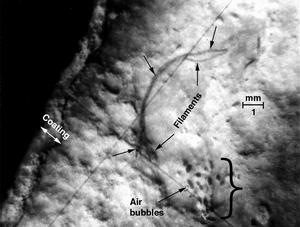Skip to comments.
Egypt's Pyramids Packed With Seashells (Not Concrete)
Discovery Channel ^
| 5-1-2008
| Jennifer Viegas
Posted on 05/01/2008 2:02:14 PM PDT by blam
click here to read article
Navigation: use the links below to view more comments.
first previous 1-20, 21-40, 41-44 last
This photo shows a sample of the casing from the ascending passage of Kheops great pyramid, given by the French egyptologist Jean-Philippe Lauer in 1982 to J. Davidovits. Now, the cross section is characterised by the presence of organic fibers and air bubbles that do not exist in normal situation, especially in a 60 million years old limestone from the eocene era

41
posted on
05/01/2008 11:09:38 PM PDT
by
SunkenCiv
(https://secure.freerepublic.com/donate/_______________________Profile updated Monday, April 28, 2008)
42
posted on
05/01/2008 11:10:41 PM PDT
by
SunkenCiv
(https://secure.freerepublic.com/donate/_______________________Profile updated Monday, April 28, 2008)
To: buffyt
43
posted on
05/02/2008 1:20:24 AM PDT
by
wafflehouse
(How many boards would the Mongols horde if the Mongol hordes got bored?)
To: SampleMan
When I visited there I remember the walls and grounds having those ‘little shells’ in them. So I looked it up. Below is a brief of the initial construction. But you are correct. Lots of renovations. It would never last thousands of years. Thanks for your post.
“Construction
The Castillo de San Marcos The Castillo is a masonry star fort made of a stone called “coquina”, literally “little shells”, made of ancient shells that have bonded together to form a type of stone similar to limestone. Workers were brought in from Havana, Cuba, to construct the fort. The coquina was quarried from Anastasia Island across the bay from the Castillo, and ferried across to the construction site. Construction lasted twenty-three years, being completed in 1695.”
44
posted on
05/02/2008 3:54:14 AM PDT
by
poobear
(tagline is on a coffee break!)
Navigation: use the links below to view more comments.
first previous 1-20, 21-40, 41-44 last
Disclaimer:
Opinions posted on Free Republic are those of the individual
posters and do not necessarily represent the opinion of Free Republic or its
management. All materials posted herein are protected by copyright law and the
exemption for fair use of copyrighted works.
FreeRepublic.com is powered by software copyright 2000-2008 John Robinson
